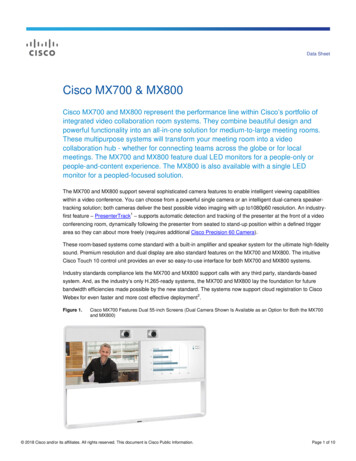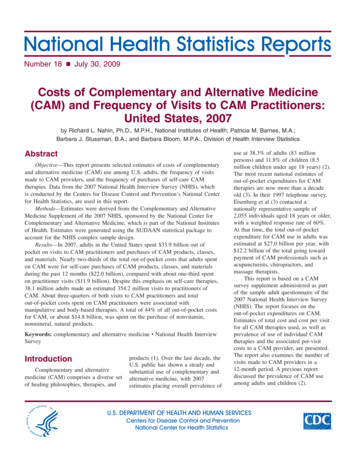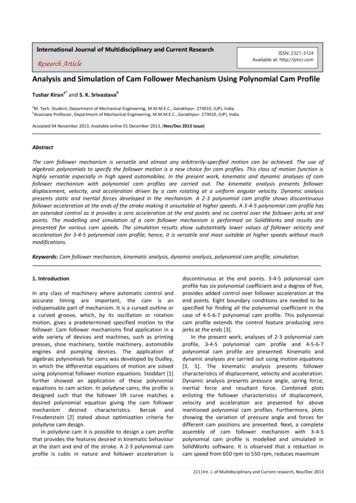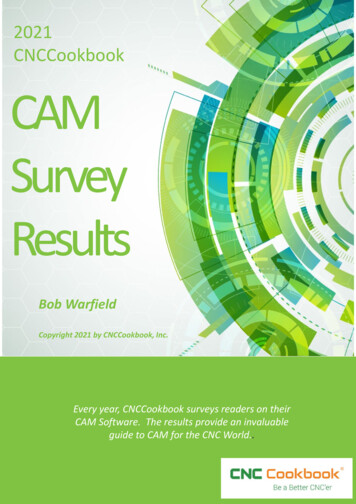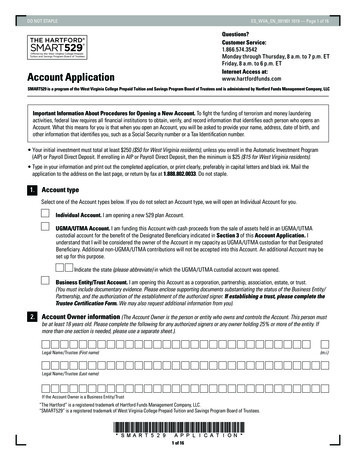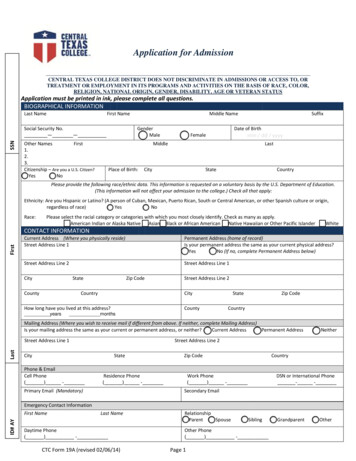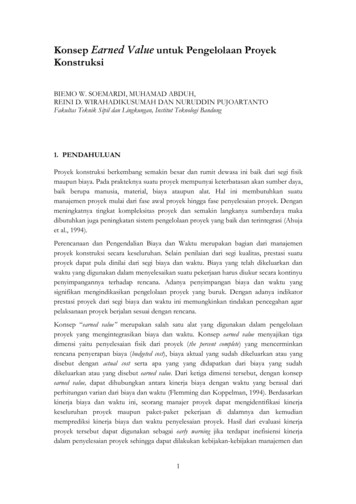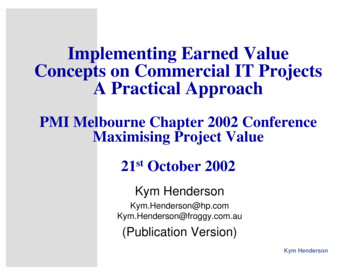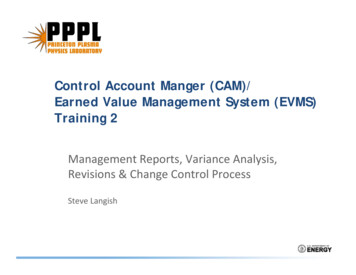
Transcription
Control Account Manger (CAM)/Earned Value Management System (EVMS)Training 2Management Reports, Variance Analysis,lRevisions & Change Control ProcessSteve Langish
Overview Quick Refresher & Snap Into EVM ModeAnalysis & Management Reports, The Extended Version–––– Revisions, The Extended Version–––– Reporting ProcessCalculations & TriggersHow To On Variance AnalysislInformation Available To YouChange Control ProcessCalculations & TriggersHow To On Change ControlInformation Available To YouTime At The End For Questions & Throughout2
Flashback - Define the work- Understand contract statusOrganization- Assign responsibilities- Use data for decisionmaking- Define indirect procedures- Establish propermanagement controlsPlanning,Scheduling, &B d tiBudgeting- Schedule all work- AuthorizeA h i allll workkAssignments made to responsibleorganizationsMaintenance ofbudget, work,and schedulerelationshipsl ti hiRevisionsAll documentsproperly maintainedDo not modifypast budget oractuals (w/opermission)i i )Analysis &ManagementRReportst- Costs Elements- CostC summarizationi i- Time-phase the work- Develop cost accountsAccountinggConsiderations3ANSI/EIA 748
Analysis & Management Reports Applicable Procedure(s)– PPPL PMSD Appedix E Procedure 8 Monthly Status Reporting Monthly Reporting Requirements On Project Status– ContractC t t PerformanceP fReportsRt (CPR(CPRs)) ‐ CustomerC t Identify Significant Differences In Schedule/Cost Performance & Provide ReasonsSummarize Data & Variances Through The WBS Elements & Compare Results WithBaselineImplement Recovery Plans, Managerial Actions, & Recommendations ResultingFrom Reports & Exceeded ThresholdsDevelopevelop Revised Estimatesstimates Basedased On Performance To Dateate & Future ((EACAC & ETC)TC)4
Analysis & Management Reports – Reporting ProcessProject Controls(a.k.a Steve &Orlando)CAM (a.k.a job manager)via monthlyy “MikeWilliams” status mtgEffort, StatusSheets, ETC/EAC,& ContributionHighlightsScheduling Tool(Primavera P3)ScheduleUpdatedCost Tool (Cobra 4.7)Create InternalPerformance Reports(eg barcharts, CPR’s,financial reports, JCR’setc)Dekker Extraction UtilityActualsImportedFrom AccountingProject Controls(a.k.a Orlando)Report Packageposted (sent toProject , DOE‐PSO andd PARS‐IIPARS II5
Analysis & Management Reports – Analysis ProcessInputp to PARS andPost on internalwebCAMs ReviewReport &SupplementalDataCAMs ResearchCAs ExceedingTh h ldThresholdVariance AnalysisRReportt (CPR5 FForm))Explanation &CorrectiveActionsReports CompiledFederal ProjectDirector ApprovesReportInformationProject ManagerReviews &AApproves
If You Recall There Are Three Key Components To Earned Value: Planned Value (PV), EarnedValue (EV) & Actual Cost (AC).– PV Is The Physical Work Scheduled Or “What You Plan To Do”– EV Is The Quantification Of The “Worth” Of The Work Done To Date Or “What YouPhysically AccomplishedAccomplished”– AC Is The Cost Incurred For Executing Work On A Project Or “What You Have Spent” Wait That’s Not What You Said Last Time – BCWS (Budgeted Cost of Work Scheduled) Value Of Work PLANNED To Be Accomplished During A Given Period Of Time. How Much WorkShould Be Done? PV– BCWP (Budgeted Cost of Work Performed) Value Of Work Accomplished Or EARNED VALUE. How Much Work Is Done? EV– ACWP (Actual Cost Of Work Performed) Cost Of Work Accomplished Or ACTUAL COST. How Much Did It Cost? AC They Are The Same Use What You Like & Be Familiar With BothRemember We Use These For All Kinds Of Fun Calculations7
Variance & Performance Indices – Quick Cheat These Essentially Help Us Analyze What Has Happened On A ProjectCost Variance (CV) EV – ACSchedule Variance (SV) EV – PVIf the result is POSITIVEÆ “Underrun”If the result is NEGATIVEÆ “Overrun”OverrunIf the result is POSITIVE Æ “On Schedule”If the result is NEGATIVE Æ “BehindBehind Schedule”ScheduleCost Variance (CV)% CV/EVSchedule Variance (SV)% SV/PVTells you what percentage cost variesfrom what has been earned to date.Tells you what percentage schedule varies fromwhat has been planned to date.Cost Performance Index ((CPI)) EV/ACSchedule Performance Index ((SPI)) EV/PVIf result is less than 1.0, cost isGREATER than budgetedIf the result greater than 1.0, cost isLESS than budgetedIf result is less than 1.0, project is“BEHIND” scheduleIf the result greater than 1.0, project is“AHEADAHEAD of schedule8
What About Those AC Things? The “At Completes” Are Used To Analyze The Future Or What Is Expected ToHappen On A Project Given The Progress Measurements Reported To DateAnticipating Future Progress Requires Determining When The Project Will BeCompleted & How Much It Will Cost To Complete ItRRememberb FromFL t TimeLastTi–BAC (Budget At Completion) –EAC (Estimate At Completion) –Estimate Of Total Cost Of All Authorized Work Thru Project CompletionCompletion. What Do We Now Expect The TotalJob To Cost?ETC (Estimate To Completion) –Sum Of All Budgets Thru Any Given Level (Without Contingency). What Was The Total Job Supposed To Cost?Estimated Value Of The Authorized Work Remaining To Be Completed. How Much Will The Remaining WorkCost?VAC (Variance At Completion) Projected Variance For The Project Thru Completion. What Is Difference From The Budgeted Amount?9
Let Me Count The Ways There Are Many Formulas That Can Be Used To Calculate The EAC– EAC ACWP ETC Used Early On In Project Execution Uses Actuals & Subjective Estimate To Complete Provided By CAMs– EAC ACWP/BCWP x BAC Assumes That The Burn‐rate Will Be The Same For The Remainder Of The Project Uses The Actuals, Performance & The BAC– EAC BAC/CPI Assumes Thath Theh Burn‐rate Willill Be Theh Same For Theh Remainderi d Off Theh Projectj Uses BAC & CPI Instead Of Actuals– I Can Keep Going But Let’s Just Get To The Punch Line We Will Use A Combination Of These Formulas– Cost Software Tool Will Suggest A Calculation– CAMs Verify All Values– PEP currently requires revised EACs every 6 months10
Quick Refresher ExampleTime NowTask NameBuilding DesignStartSite InspectionPhase 1 DesignPhase 2 DesignFinal 2/2002DurBCWS031431522100150200120EV 50200120Using a Building Design Schedule, assume that “Building Design” is your WBS Elementand the tasks are your activities. You can see that the Site Inspection task is completeand the Phase 1 design is in progress and 33% complete. Your actual cost (via yourtimecards etc) is 275timecards, 275.CV (BCWP-ACWP)What Are The Other Values?SV (BCWP-BCWS)CPI ((BCWP/ACWP)CC/ C)SPI (BCWP/BCWS)Budget at Complete (BAC)Planned Work (BCWS)W kPWorkPerformedfd (BCWP)Actuals (ACWP)ETC (BAC-BCWP)EAC (ACWP ETC) 275VAC (BAC-EAC)11
Quick Refresher ExampleTime NowTask NameBuilding DesignStartSite InspectionPhase 1 DesignPhase 2 DesignFinal 2/2002DurBCWS031431522100150200120EV 50200120Using a Building Design Schedule, assume that “Building Design” is your WBS Elementand the tasks are your activities. You can see that the Site Inspection task is completeand the Phase 1 design is in progress and 33% complete. Your actual cost (via yourtimecards etc) is 275.timecards, 275CV (BCWP-ACWP)( 125)What Are The Other Values?Budget at Complete (BAC)Planned Work (BCWS)W kPWorkPerformedfd (BCWP)Actuals (ACWP) 570 200 150 275SV (BCWP-BCWS)( 50)CPI ((BCWP/ACWP)CC/ C)0.55055SPI (BCWP/BCWS)0.75ETC (BAC-BCWP) 420EAC (ACWP ETC) 695VAC (BAC-EAC)( 125)12
CPR Format 1 The Example Given Will Be Just Like Our Reports13
CPR Format 214
CPR Format 215
CPR Format 316
CPR Format 517
Problem AnalysisYou WILL have variances on your jobs!The real question is what’s the impact, how are you communicating, and whatare you doing to minimize impact. In other words are you managing your job. Start With What You Are Talking About– Unfavorable Cumulative Cost Variance Of 17K Round Amounts To The Nearest K Dollar & Eliminate The Don’t Worry About Negative Signs, Just Use Unfavorable Itemize The Reasons For The Variance If There Were More Than One & NumberThe List Of Reasons– (1) Contributing To 6K Of The Unfavorable Variance, Labor – ((2)) Materials Made Upp 4K Of The Unfavorable Variance Why Did The Variance Occur & If Cumulative Variance, When?– Contributing To 6K Of The Unfavorable Variance, The Task Was More Complex ThanOriginally Planned, Resulting In More Labor Being Used Than Was Planned In May Won’t Earn You An Ice Cream Surprise To Only Say–––––Spent More Than I PlannedSomeone Charged Extra HoursI DidDidn’t’t EarnEEEnoughh BCWPSee Last Month’s ReportBilling Lag18
Uh What Kind? Determine What Type Of Variance– Technical Design Issues Manufacturing Process Problems/Problems Hardware/Software– Organizational Personnel AvailabilitySkill MixPrioritiesInterfaces/Communication– External Contractual Issues With Subs & Vendors Acts Of Nature Approvals– Management System Time‐phasingpg BCWP Technique Original Estimate19
Impact What Is The Impact To The Delivery Or Program? Why Is The Impact RecoverableOr Unrecoverable?– The Variance Will Be Recovered When Labor Returns To This Task In The Next ReportingPeriod, Resulting In No Overall Impact To The Program– Without More Budget,Budget The Impact Is Unrecoverable Won’t Win You A Gold Star To Only Say– None– No Impactp– This Control Account Will Continue To Overrun In Coming Months20
Corrective Action Who Will Undertake The Action? When Will It Take Place?– CAM Will Work Closely In Weekly Telecons With Subcontractor To Expedite Delivery,Impact Will Be Recovered– We Have Been In Contact With The Supplier To Make Sure The Delivery Will Be Made InAugust. We Will Take Full EV Upon Receipt What Are The Cost Trade Offs?Not So Hot Examples– None Requiredq– I Should Be Able To Make Up The Overrun DownstreamMake Sure You Do What You Said You Will. They Will Be Checking And We Will BeWatching 21
Examples Of Good Variance Analysis Problem Analysis (Cause)–– Impact–– The 14k negative cost variance is due to reworking the upper housing design ( 8.4k) and using amore expensive design of the tracking mechanism ( 5.6k).The 17.5k negative schedule variance is due to the slip in the deliveries of the microprocessor. Theentire 17.5k was the value (BCWS) of that particular delivery.The rework of the upper housing is not recoverable ( 8.4k); however, the more senior experiencedengineer is expected to perform the next task in less time which will eliminate the negative 5.6kvariance.There is no impact. The earned value (BCWP) will be taken as soon as the microprocessor isdelivered (in approximately 2 weeks) which will eliminate the 17.5k negative schedule variance.Also, this late delivery will not affect any subsequent deliveries.Corrective Action––Modify the documentation on the upper housing to ensure this will not happen to similar typedesign. Monitor more closely the design engineers to ensure their efficiency.Have been in contact with the microprocessor supplier to make sure any further slippage in schedulewill not happen.22
How To Analyze Cost Variance Compare Actual Cost To Date (ACWP) To The Planned Cost (BCWS)Ask Yourself The Following Questions:– What Is Causing The Cost Overrun/Underrun?– Are The Costs Recoverable?– Does Theh Cost Variance Represent Whath Is Actuallyll Happening? Cost Variances Can Impact ContingencyDepending On The Answer To The Questions, Several Things Can Happen– AAre TheTh OOverruns/Underruns/U dD ToDueT BadB d ChCharges OOr AAccruals?l ? If SSo, BBackk OOutt ThTheMischarge Or Accrual– If The Costs Are Recoverable By Replanning Future Work (Not Removing Scope) Then DoSo. However, If The Task Has Already Started This Will Not Be possible. You Have To BeForward Looking & Replan Tasks That Lend Themselves To Saving Money.23
Cost Variance Statements – FavorableBCWP ACWPFavorable The Cost Variance Is Favorable Because 1.2.3.44.5.6.7.The Complexity Of The Task Is Less Than Originally EstimatedThe Less Complex Tasks Have Been Completed EarlyFewer Revisions & Rework Than PlannedTh TTaskk IIs PThePrimarilyiil LOE & HHas NNott BBeen FFullyll StaffedSt ff dEarned Value Is IncorrectMaterial Or Services Have Been Used But Not Paid ForMaterial Or Services Were Cheaper Than Planned (Favorable MarketFluctuations, Rate Decrease)8. Efficiencies Were Realized (Leveraging Of Other Work)9. The Plan Is Poorly Time‐phased24
Cost Variance Statements – UnfavorableBCWP ACWPUnfavorable The Cost Variance Is Unfavorable Because 1. The Task Is More Complex Than Originally Planned2. The More Complex Tasks Have Been Completed Early3. Program Priorities Have Resulted In Application Of Resources In AnInefficient Manner : More OvertimeOvertime, Additional StaffingStaffing, Etc4. Delays In Receipt Of Data Have Resulted In Implementation Of Work‐A‐Rounds To Make Schedule: More Overtime, Additional Staffing, Etc5. Changes, Redesign, Additional Requirements, Unclear Requirements,Or Out Of Scope Effort6. The Plan Is Poorly Time‐phased7. Earned Value Is Incorrect8 Opposite Rate Changes Or Use Variances Noted In Favorable8.25
How To Analyze Schedule Variance Compare The Current Schedule To The Baseline Schedule.Ask Yourself The Following Questions:– Have you accomplished the tasks that were planned thus far?– Are the tasks not accomplished still valid?– Does theh scheduleh d l variance represent whath is actuallyll happening?h? “Yes” To These Questions, The Schedule Variance Is Legitimate & Reportable“No”, The Tasks Beyond The Current Period Should Be Reviewed & Can BeUpdatedChange Requests To Correct A Variance That Has Already Occurred Are NOTAllowed– Can Be Used To Correct The Plan For Future Work– Accommodate A New Workaround Plan To Enable You To Bring The Work In OnSchedule On Budget26
Schedule Variance Statements – FavorableBCWP BCWSFavorable The Schedule Variance Is Favorable Because 1. The Task Is Less Complex & Will Be Completed Earlier Than Planned2. Early Effort Has Been Confined To Tasks Which Are Less ComplexThan Those That Follow3 The Task Has Been Overstaffed Early In Order To Recognize The3.Establishment Of A Higher Priority4. Deliveries Of Hardware Have Been Accomplished In Advance Of NeedDate5. Efficiencies Were Realized (Leveraging Of Other Work)6. Earned Value May Be Incorrect & Require An Adjustment In The NextReporting Period7. The Plan Is Poorly TimeTime‐phasedphased & The Current Status Is Not ReflectiveOf What Is Really Happening27
Schedule Variance Statements – UnfavorableBCWP BCWSUnfavorable The Schedule Variance Is Unfavorable Because 1.2.3.44.5.6.The Task Is More Complex Than Originally PlannedEarly Effort Has Been More Complex Than The Effort That FollowsDelays In Staffing Have Slowed ProgressH dHardwareDDeliveriesli i AreA LLatetRedesign Of Rework Activities Has Delayed ProgressData From Another Organization (Drawings Or Technical Analysis)Has Been Late7. Additional Requirements Have Been Established Or Changed8. Higher Priority Has Been Established On Other Work9. The Plan Is Poorly Time‐phased10. Earned Value Is Incorrect28
Variance Write-Ups Key Points Be Specific– Without Being Too Wordy, Describe Each Reason For The Variance In Detail Avoid Using A Lot Of Explanation To Essentially Say Nothing (no jokes here)– Back Your Variance With Facts After The Variance, Take Action To Ensure That The Next Report Is Not Just AsUnfavorable– Make Sure To Follow Through With Your Corrective Action Don’tt Hesitate To Seek Help In Writing Your Variance Analysis Reports (VARs)Don– It’s Easier To Learn How To Write It Correctly The First Time Than To Edit It In A LengthyReview Essentially,y, All Roads Lead Back To The CAM – It’s Your Control Account– Be Prepared To Explain What You Write– Take Ownership Of Your VARContext, Consistency, Clarity, Completeness, Conciseness, Correctness29
Chasing It All Down Start With The CPR Provided– Review Every Exceeded Threshold For Your Control Account Level– Look At Cumulative & Current Review The Report Package Provided– Detailedl d Monthlyhl Cost/Hours/Report– Check For Unusual Trends Or Upcoming Spikes In Activity Look At The SPI/CPI & SV/CV Charts For Trends30
Analysis & Management Reports – ReportingExampleNSTX Upgrade Project Performance since CD‐2 Approval2100020000Dollar ( 0178691887831
Analysis & Management Reports – ReportingExampleNSTX UPGRADE PROJECT OVERALLNSTX UPGRADE PROJECT OVERALL1.101.101.071.051.031.041.051.071.061 051.051.061 051.051.021.011.001.000.991.000 980.980.970.970.970.960.960.950.95Project Total SPIProject Total ‐1032
When Is It Most Useful? Due To The Natural Behavior Of Projects, There Are Points Where EVM Is LessUseful Than Others– The First Few Months (Anywhere From 3 – 6) Can Be Misleading– The Last 10% Of Execution NoticeNti WhatWh t HappensHAsAThe Project ReachesCompletion BCWS BCWPContingency– Thus SPI 1.0 & SV 0 This Can Permeate ThroughThe Other EVM MetricsNever Fear We Will WatchDoesn’t Get You Out OfExplaining Variances33
Revisions Applicable Procedure(s)– PMSD Appendix E Procedure 9 Change Control Establish Change Management System With ThresholdsIncorporate, Control, & Document Authorized & Retroactive Changes (IncludesCost, Schedule,h d l Scope, & Administrative)d i ii )Record Updates & Effects To Budget & SchedulePrevent Unauthorized Changes To BaselineWhat Formal Documents Are Used?– Engineering Change Proposal (ECP) When Can Changes Occur?–––––ContractualCt t l ChChanges/Modifications/M difi tiThe Use Of ContingencyRe‐PlanningFormal Reprogrammingp ggBottom Line: Any Change To Scope (Technical), Responsibility, Schedule, Or Budget34
ECP FormGeneral Information & Explanation:This section covers general info and isused to explain the drivers, abnormalconditions and factors creating the needconditions,for change. Information is taken from thenext pageLevels:This section outlines if DOE Approval isrequired and what the proposed changeLevel will be.Result & Signatures:This section documents the final approvaland dates. It is also used to outline thesignatures required (either for approval orconcurrence).35
ECP FormThis section is completed by theoriginator.36
Revisions – Thresholds Change Approval Thresholds37
Project Change Control Log jectStatus/Configuration Control/ECPindex.htm38
Look Ahead EVMS Rules State That The Past Through The Current Month Baseline Is FrozenChanges Can Only Be Made To The Work Beyond The Current MonthCompare, In Detail, The Current Schedule To The Baseline Schedule Every 2‐3MonthsWhat Is Coming Up? (Look Ahead About 6 Months)– What Are Your Critical Paths & Key Milestones? Ask Yourself The Following Questions– DDoes ThThe CCurrent ScheduleS h d l SStillill TrackT k CloselyCl l ToT TheTh BaselineB li Schedule?S h d l ?– Does The Baseline Schedule Represent The Work That Will Be Performed In The Next 6Months?– Is The Planned Budgetg Sufficient?– Are The Risks Sufficiently Captured & Controlled?– Are Your Requirements Or Scope The Same? If You Answer “Yes” To These Questions, No Update Is NecessaryIf You Answer “No” To These Questions, The Future Scheduled Plan Should BeReviewed & Updated With A Change Request – If Needed39
Hiding The Uglies Changes Are Not To Be Made To Hide Or Eliminate VarianceThis Is Not Allowed In EVM, As Continuous Changes To The Baseline:–––––– Signals Poor PlanningHides Potential ProblemsCouldld Be A Constant Drain On ContingencyInhibits Accurate Forecasting & Trend AnalysisDecreases Confidence In BaselineCauses Controls Group To Drink Heavily & Be Cranky YouCranky You DonDon’tt Want To See ShereseCranky It Isn’t PrettyChange Requests Should Only Be Processed When The Plan Diverges From TheBaseline So Much That It Becomes Obsolete40
Rebaselining (Replanning vs. Reprogramming) Replanning: is a realignment of schedule or reallocation of budget for remainingeffort within the existing constraints of the contract.– Total allocated budget does not exeed CBB (PMB MR)– Schedule is NOT adjusted to extend beyond the contractually defined milestones– Includes movement of budget within a Control AccountAccount, between Control Accounts,Accounts andapplication of MR Reprogramming: is a comprehensive replanning of the remaining performancemanagement baseline that results in a total budget and/or total schedule in excessof contractual requirements.– Remaining available budget insufficient to ensure valid performance measurement– Restores much needed control to a contract that has had poor execution or anunrealistic plan for the remaining work– Key benefit is an executable and achievable baseline plan, renewed buy‐in from theproject team, and meaningful performance indicators, and restored confidence41
You’re Rolling What?O N DJF M A MJA S2007200820092010 164000Control Account:Work Package: PEDJ 4000EVT: MS %Com p 1000 1000 1000Work Package: CON 10000EVT: MS %Com p 3000 3500 3500Planning Package:CON 150000Work Which Cannot Readily Be Planned In Detailed Work Packages Is Planned InPlanning PackagesPlanning Packages Should Be Decomposed Into Detailed Work Packages As SoonAs The CAM Has Sufficient VisibilityIdeally, This Is At Least 6 Months Before The Work In The Planning Package IsScheduled To Start42
Funding Vs Budget You Mean They ArenAren‘tt The Same Thing? Æ NO! They Are Very Different.DifferentBudget (Money agreed to! Money needed!)–––– Typically Developed By Project TeamEstimate For Total TasksPhased Over Baseline ScheduleBasis For Earned Value PerformanceMeasurementFunding(Money in the bank ready to be spent)– Typically Issued From Sponsor– Current Estimate Of Total DollarRequirements– Phased By Distribution Period (FY)– Typically Handled Thru Division Office Oh Maybe This Will Help, Too You Can Go To Jail For Funding Not For Budget43
Aaaaaaahhhhhhhhh!WHAT DO I DO?!?!44
Get To Know Your CAM NotebookRelax We’ve Got You Covered: Stay Calm Review Your CAM Notebook(Including The Procedures) We Are All Available To TakeQuestions YYou Will NotN t BeB All Alone YourAlYNotebook Is Your Binky45
Questions, Questions, Questions System Focused– Is The System Documented & In Compliance With The EVMS Guidelines?– Does The Entire Project Team Understand How To Use The System & Data?– Are The Internal & External Reporting Structures Operating Effectively? Control Account Focused––––––––––What Is The Scope Of Work & How Is It Verified?What Is The Period Of Performance?What Organization Is Responsible For The Work?What EV Measurement Methods Are Used & Why?What Milestones Are Included Or Relate & What Are The Entrance/Exit Criteria?What Is The Scheduled Completion Date For Activity XYZ?What Is The Unit Of Measure For Resources?How Was The Budget For Your Work Developed?Is Your Budget Adequate? If It Is Not, What Are Your Options?Explain The Time‐phasing Of Your Budget46
Still Going Still Control Account Focused––––––––––––How Do You Develop Estimates To Complete?What Rates Are Used In The Baseline?How Does The Team Communicate?H Did YouHowY PlPlan ThThe WWork?k?How Do You Identify & Manage Schedule Impacts?Who Owes You Things & How Do You Track Them?Iss All OOf Yourou Worko Authorized?ut o edWhat Risks Exist & How Are They Addressed?What Assumptions Are Built Into Your Schedule (Task & Budget)?How Is Contingency Calculated?What Is The BAC & EAC (LRE)?What Is The SV & CV?47
Questions?48
- EAC ACWP/BCWP x BAC Assumes That The Burn‐rate Will Be The Same For The Remainder Of The Project Uses The Actuals, Performance & The BAC - EAC BAC/CPI Assumes That The Burn‐rate Will Be The Same For The Remaidinder Of The Project Uses BAC & CPI Instead Of Actuals
